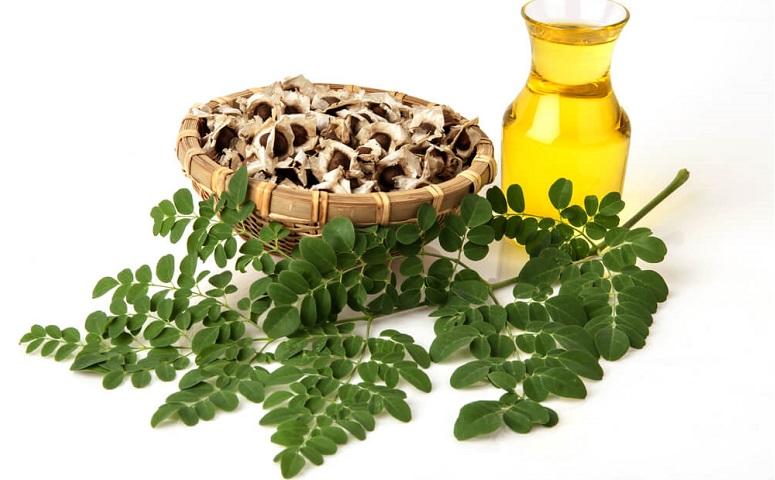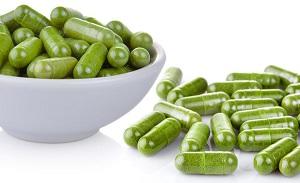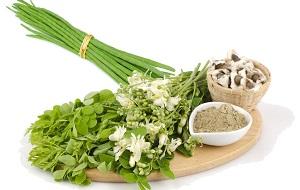What Exactly Is Moringa?
Moringa is a plant native to parts of Africa and Asia and is the sole genus in the flowering plant family Moringaceae. The name is derived from the word for 'drumstick' and is a fast-growing, tall, leafy plant that produces flowers or pods. It ranges in size from tiny herbs to massive trees. The most widely cultivated species is a tree native to the foothills of the Himalayas in northwestern India and cultivated throughout the tropics - called Moringa oleifera or, ‘The Miracle Tree’.
An amazing characteristic of the Moringa tree is that it’s capable of growing in depleted or dry soils where many other types of beneficial plants or trees cannot survive. This is precisely why certain undernourished populations living in third-world countries, such as India or Somalia, have benefited from moringa during times of famine.
Moringa is also used to help restore fertile soil, in forest restoration efforts, to filter water, produce an oil that benefits the skin, and also in the manufacturing of certain medications or supplements. The plant can be grown all year round and as it progresses through its life cycle it actually helps replenish diminished minerals and other substances. Even as it decomposes, the Moringa tree helps provide a way for populations to better grow other sources of food in difficult landscapes with barren soil.
Moringa Ovalifolia
A variant of the Moringa tree is the Moringa ovalifolia. Moringa ovalifolia is found in the dry, desert and semi-desert areas of Namibia, Africa. It is decorative, succulent-stemmed and thickset. You will find it on the rocky escarpment passes in the northern and central areas adjacent to the Namib desert. It has a dense population in the Sprokieswoud in Etosha National Park.
Moringa ovalifolia is an easily spotted, tall (up to 7m high) tree which stands up straight. It is deciduous and bears a succulent main branch up to 1 m in diameter which is often bottle-shaped. The roots are fleshy with a bark that is smooth brown to silvery copper, with a shiny green sheen, and resinous.
The leaves tend to droop are alternately arranged. The specific variant of Moringa ovalifolia, refers to its oval leaflets. They sprout white flowers, each up to 3mm in diameter with 4-5 petals. The flowering season is mainly from November to May and you can expect fruit between October and May.
Growing Moringa Ovalifolia
Moringa ovalifolia is best suited to warm, dry, frost-free, bushveld or desert gardens. It is planted singly or in groups. It grows best in a sunny situation on a well-drained slope.
Moringa ovalifolia easily propagates from seed during the warm summer months. The young trees grow quite fast but need to dry off during winter. It is not frost resistant. In cold regions, it should be kept as a pot plant under greenhouse conditions.
Interesting Nutritional Facts About Moringa
- 25 x more Iron than in spinach
- 4 x more Protein than in eggs
- 0.75 x more Vitamin C than in oranges
- 10 x more Vitamin A than found in carrots
- 15 x more Potassium than in bananas
- 17 x more Calcium than found in milk
The Benefits Of Moringa
It has been used extensively in traditional medicine practices such as Ayurveda medicine for over 4,000 years! When it comes to our health, Moringa is something that health professionals around the world have used to attend to a variety of symptoms including, amongst others, malnutrition.
- It Is Nutrient Packed
Moringa contains significant amounts of Vitamin A, C and E, potassium, calcium as well as protein. It is a very rich source of vitamins, minerals, and amino acids.
- It Supports Brain Health
Moringa supports brain health as well as cognitive functioning due to its antioxidant and Neuro-enhancer activities. There have been favorable preliminary results where it has been tested as a treatment for Alzheimer's disease.
- It Enhances Wound Healing
There are blood-clotting properties in Moringa’s leaves, roots, and seeds that benefit wound healing and its ability to reduce clotting time.
- It Helps With Some Diabetes Symptoms
When it comes to reducing lipid and glucose levels as well as regulating oxidative stress, Moringa leaf powder has been shown to be very effective.
- It Protects The Cardiovascular System
When it comes to promoting good cardiovascular health, particularly in blood lipid control, the prevention of plaque formation in the arteries, and reduced cholesterol levels, Moringa leaf powder has been proven to be highly effective.
Top Health Benefits From Moringa
Moringa Protects The Liver
The liver is responsible for detoxifying the blood, fructose metabolism, bile production, nutrient processing and fat metabolism. It can only fulfill these duties with the help of liver enzymes, therefore it is vital that they remain at normal levels. Just as an example, lower levels of hepatic enzymes can impair its ability for blood filtering. Within Moringa lie high concentrations of polyphenols in its flowers and leaves which protect the very precious liver against toxicity, oxidation, and damage.
Moringa is able to reduce liver damage and fibrosis as well as reverse oxidation in the liver. Moringa oil is also able to restore liver enzymes to normal levels, increasing protein content in the liver, and reducing oxidative stress.
Moringa Fights Inflammation
Having inflammation in the body leads to chronic diseases such as diabetes, respiratory problems, arthritis, obesity and cardiovascular disease. How does Moringa reduce inflammation? Moringa reduces inflammation by suppressing inflammatory enzymes and proteins in the body, and Moringa leaf concentrate is able to significantly lower inflammation in the cells.
Moringa Contains Antimicrobial and Antibacterial Properties
Moringa fights infections as it has antibacterial as well as anti-fungal properties. It has been effective against types of fungi that cause skin infections and strains of bacteria responsible for blood and urinary tract infections as well as digestive problems.
Moringa Fights Free Radicals
Antioxidants are needed to fight free radicals as these free radicals cause cell damage, oxidative stress and inflammation. The antioxidants found within Moringa are called polyphenols, flavonoids, and ascorbic acid found within the leaves, seeds as well as flowers.
The leaf extracts prevents the damage and degradation that free radicals cause in the cells of different organs in the body, keeping them healthy and functioning at their best.
The leaf extracts have higher antioxidant activity, free-radical-scavenging capacity, as well as higher inhibition of lipid, protein, and DNA oxidation than flowers and seeds.
How Can We Incorporate Moringa Into Our Diet?
By Drinking Moringa Tea
Moringa Tea is made from dried leaves steeped in hot water. The most nutrient-dense types are organic and slowly dried under low temperatures, which helps preserve delicate compounds.
By Ingesting Dried Moringa Leaves Or Powder
It takes around seven pounds of Moringa leaves to make one pound of dried powder. The leaves are considered the most potent parts of the plant. They contain the largest amount of antioxidants and available macronutrients. Look for Moringa dried leaves in capsule, powder or tea form, and it’s best taken with a meal.
By Using Moringa Oil
The oil from Moringa seeds is sometimes called Ben oil. Look for it in natural creams or lotions. Keep the oil in a cool, dark place away from high temperatures or the sun
By Ingesting Moringa Seeds
Moringa pods and flowers seem to have a high phenolic content along with proteins and fatty acids. These are the parts of the plant used to purify water and add protein to low-nutrient diets. You will find them added to creams, capsules and powders. The immature green pods of the plant are often called “drumsticks” and are prepared similarly to green beans. The seeds that are found inside the pods are removed and roasted or dried just like nuts to preserve their freshness.
Caution:
Moringa can cause laxative effects and an upset stomach when overused.
It is not recommended for pregnant women or those with existing medical conditions, it is always best to check with your doctor before taking any new supplement.
Interestingly, there are several studies which suggest Moringa may actually be beneficial for breast milk production. Always check with your doctor or nutritionist when taking any new health supplement.
Academic References:
Moringa oleifera: A Review of the Medical Evidence for Its Nutritional, Therapeutic, and Prophylactic Properties, Part 1 by Jed W. Fahey, Sc.D.
Free radicals, antioxidants and functional foods: Impact on human health by V.Lobo, A. Phatak and N.Chandra, Department of Botany, Birla College, Kalyan, India
A double-blind, randomized controlled trial on the use of malunggay (Moringa oleifera) for augmentation of the volume of breastmilk among non-nursing mothers of preterm infants by Ma. Corazon P. Estrella, MD., Jacinto Blas V. Mantaring III, M.D., Grace Z. David, M.D., Michelle A. Taup, M.D. from the Department of Pediatrics, UP PGH Medical Center
Moringa Oleifera: A food plant with multiple medicinal uses.
Anwar F, Latif S, Ashraf M, Gilani AH.
Department of Chemistry, University of Agriculture, Faisalabad-38040, Pakistan.
PMID: 17089328 [PubMed – indexed for MEDLINE]
Bioresource Technology. 2007 Jan;98(1):232-6. Epub 2006 Jan 6.
Moringa, Nature’s Medicine Cabinet “It is a remarkable tree whose leaves, pods and flowers have 7 times the Vitamin C found in oranges, 4 times the Vitamin A of carrots, 3 times the iron of spinach, 4 times as much calcium as milk and 3 times the potassium of bananas.” Stanford Holst
Anti-fungal activity of crude extracts and essential oil of Moringa oleifera Lam.
Chuang PH, Lee CW, Chou JY, Murugan M, Shieh BJ, Chen HM.
Institute of Bioagricultural Sciences, Academia Sinica, Taipei 115, Taiwan, ROC.
PMID: 16406607 [PubMed – indexed for MEDLINE] J Med Food. 2002 Fall;5(3):171-7.
Hypocholesterolemic effects of crude extract of leaf of Moringa oleifera Lam in high-fat diets. Department of Pharmacology and Therapeutics, University of Nigeria, Enugu. PubMed ID: 10661880
Moringa Ovalifolia by Ernst van Jaarsveld, Kirstenbosch National Botanical Garden, http://pza.sanbi.org/moringa-ovalifolia, January 2007.
Coates Palgrave, K. 1977. Trees of southern Africa. Struik, Cape Town.
Curtis, B. & Mannheimer, C. 2005. Tree atlas of Nambia. National Botanical Research Institute, Windhoek.
Heywood, V.H. (ed.). 1978. Flowering plants of the World. Oxford University Press.
Jackson, W.P.U. Origins and meanings of names of South African plant genera. University of Cape Town Ecolab, Botany Department, Cape Town.
Van Wyk, B-E. 2005. Food plants of the World. Briza Publications, Pretoria.
Van Wyk, B-E. & Wink, M. 2004. Medicinal plants of the World. Briza Publications, Pretoria.
















